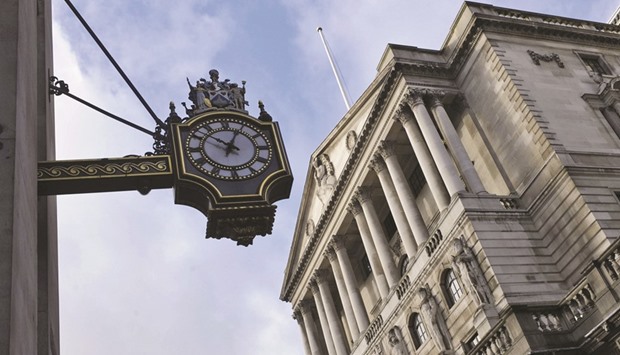The odds are stacking up against the pound for 2016.
With growth slowing and the potential for a referendum on Britain’s future in the European Union as soon as June, options traders are the most bearish on the pound in more than six months. The currency has undershot analysts’ forecasts by the most since 2010 this year, while predictions for the end of 2016 haven’t been lower since the week of the general election in May.
After the Federal Reserve increased interest rates for the first time in almost a decade this month, the risk is that concern about the EU vote will leave the Bank of England lagging further behind its US peer, weighing on the pound’s outlook. In the past 20 years, the BoE has tended to follow its US counterpart with a lag of about three months, according to economists at Deutsche Bank. But markets currently aren’t pricing in a full rate increase until the first quarter of 2017.
Britain leaving the EU “is a lose-lose” situation that “could delay any hike from the Bank of England,” said Vincent Chaigneau, global head of rates and foreign-exchange strategy at Societe Generale in London. “In this context there is scope for short-term rate differentials to widen to push cable to the downside,” he said, referring to the pound versus the dollar.
The premium for three-month options to sell sterling versus the greenback reached 1.2 percentage points on Monday, the most since June, risk-reversal data compiled by Bloomberg show. The pound was little changed at $1.4871 as of 9:45 a.m. London time, after dropping to $1.4806 on December 22, the weakest since April 15.
SocGen predicts the pound will drop to $1.41 by the end of September, a level not seen since 2009. The median forecast of economists surveyed by Bloomberg is for Britain’s currency to end that month at $1.52, with the prediction trending lower since early November.
Even so, that split shows that not all strategists are convinced by the risks that an EU vote would pose. The most recent poll of voting intentions, released last week, found 45% of respondents saying they’d opt to stay in, with 38% preferring an exit.
Manuel Oliveri, a foreign-exchange strategist at Credit Agricole’s corporate and investment-banking unit in London, is in the more bullish camp. He said sterling has the “biggest upside risk” among Group-of-10 currencies.
Once the referendum uncertainty dissipates, the capital- flow situation will be positive again, he said.
“Then the focus is completely shifting back to the rate outlook and then the market will once again understand the BoE is well ahead of other central banks after the Fed.”
One factor going against the pound is its own strength. Deutsche Bank’s sterling trade-weighted index is set to gain this year, as it has done in all but one year since 2010. It soared to its strongest level in more than seven years against the euro in July.
Even the pound’s decline this year versus the broadly stronger dollar, which has benefited from the Fed rate hike, is muted in comparison to other G-10 currencies.
With inflation near zero, well below the Bank of England’s 2% target, officials have kept UK rates at a record-low 0.5% throughout 2015. A report last week showed the economy expanded 0.4% in the third quarter, down from a revised 0.5% in the previous three months.
Forward contracts based on the sterling overnight index average, or Sonia, aren’t fully pricing in a 25-basis-point increase to interest rates until 2017. In the US, markets are signalling a more than 50% chance of a second rate increase by March.
“Over the course of the past six years being a pound bull has proved one of the easier calls for forecasters,” Simon Derrick, chief currency strategist in London at Bank of New York Mellon Corp, wrote in a note to clients last week.
“While shifting expectations about the future path of monetary policy in the UK are likely to remain the dominant issue in determining the performance of GBP in the months ahead, other factors also suggest caution might be warranted.”

A view of the Bank of England (BoE) in London. After the US Federal Reserve increased interest rates for the first time in almost a decade this month, the risk is that concern about the EU referendum will leave the BoE lagging further behind its US peer, weighing on the pound’s outlook.


